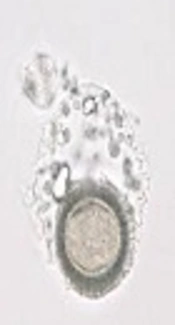Dear Editor,
Taenia genus is the group of parasites that can cause infection in humans. The invasive form of the infection is possible and can cause the internal parasitic cystic lesion namely cysticercosis. The cysticercosis lesion can be observed at any organ and the most fatal lesion is at the brain, which is clinically known as cerebral neurocysticercosis. At least three common species can cause neurocysticercosis including Taenia solium, T. asiatica, and T. martis (1). Recently, T. multiceps also proposed as a new species causing neurocysticercosis (2) and ship is its intermediate host (2).
Nevertheless, there are also other atypical species that can cause invasive cysticercosis in internal organs of human beings. Those species are usually forgotten human infections. The case of T. crassiceps infection is already mentioned for its importance due to causing invasive cysticercosis in the cases with immune deficiency (3-5). The infection is a zoonosis from fox (2-4). According to a recent report on human cysticercosis from Germany (5), there is an additional species considered as the fifth species, T. serialis (coenurosis) that can cause invasive cystcercosis in human beings. In the same study (5), T. crassiceps was also detected. The two species, T. crassiceps and T. serialis (coenurosis), are interesting uncommon findings (5). The clinical presentations of the two species are similar to the other species that can cause human cysticercosis. The silent internal cystic lesion, usually accidentally detected, is the most common clinical presentation. The diagnosis is usually due to the examination of excision specimen by molecular diagnosis. The new species are considered emerging zoonosis from dog. Based on the author’s experience in a tropical country, Thailand, the diagnosis of atypical cysticercosis seems to be difficult, since the pathological laboratories usually diagnose the cysticercosis without species classification.
